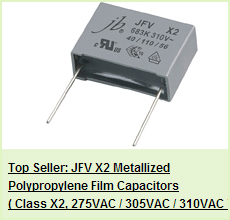jb Capacitor Construction
The parallel plate capacitor is the simplest form of capacitor and its capacitance value is fixed by the surface area of the conductive plates and the distance or separation between them. Altering any two of these values alters the the value of its capacitance and this forms the basis of operation of the variable capacitors. Also, because capacitors store the energy of the electrons in the form of an electrical charge on the plates the larger the plates and/or smaller their separation the greater will be the charge that the capacitor holds for any given voltage across its plates. In other words, larger plates, smaller distance, more capacitance.
By applying a voltage to a capacitor and measuring the charge on the plates, the ratio of the charge Q to the voltage V will give the capacitance value of the capacitor and is therefore given as: C = Q/V this equation can also be re-arranged to give the more familiar formula for the quantity of charge on the plates as: Q = C x V
Although we have said that the charge is stored on the plates of a capacitor, it is more correct to say that the energy within the charge is stored in an "electrostatic field" between the two plates. When an electric current flows into the capacitor, charging it up, the electrostatic field becomes more stronger as it stores more energy. Likewise, as the current flows out of the capacitor, discharging it, the potential difference between the two plates decreases and the electrostatic field decreases as the energy moves out of the plates.
The property of a capacitor to store charge on its plates in the form of an electrostatic field is called the Capacitance of the capacitor. Not only that, but capacitance is also the property of a capacitor which resists the change of voltage across it.






0 Comment so far
Leave a reply